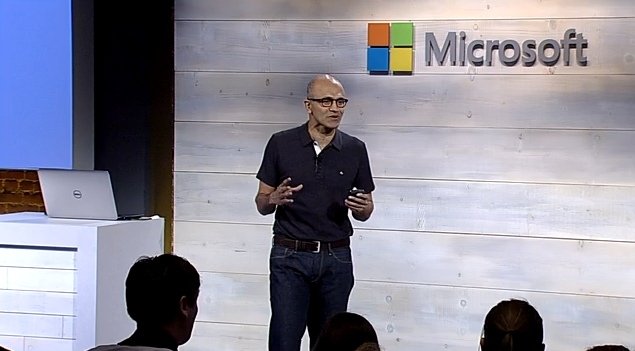
Microsoft announced new features, services and partnerships for its Azure cloud platform at a press event today.
The company unveiled a new Azure Marketplace of virtual machines, apps and services for customers to browse and purchase, and for ISVs and startups to help monetize their businesses. It also announced a partnership with Cloudera support for the CoreOS Linux distribution, a new Cloud Platform System, a new G family of virtual machine sizes and the Azure Premium Storage service.
“We want to empower every individual and organization to thrive in this mobile-first, cloud-first world,” said Microsoft CEO Satya Nadella. “It’s not about the mobility of the device, but it’s about the mobility of the experience you as individuals interact with in your life and your day-to-day.”
Coming off its recent partnership with Docker, Microsoft also announced Azure support for CoreOS, the container-optimized Linux distribution. CoreOS marks the fifth Linux distribution supported in Azure in addition to Ubuntu, CentOS, Oracle Linux and SUSE.
“We think this container-based approach helps dramatically with the creation of next generation applications and enables them to be deployed more efficiently,” said Scott Guthrie, EVP of Microsoft’s cloud and enterprise group.
After announcing the Azure Marketplace and CoreOS support, Guthrie then brought out a surprise guest—Cloudera cofounder Mike Olson—to reveal a partnership between the two companies to deliver Cloudera on Azure.
Olson explained how over the past eight months, Cloudera has combined its back-end tooling with Microsoft UIs and exploratory tools to deliver more value on Big Data. Cloudera for Azure, available through the Azure Marketplace, offers customers using Cloudera’s Hadoop management services to leverage Azure to deploy and analyze Big Data clusters.
Cloudera customers can now spin up Azure virtual machines and analyze Big Data using dashboards in Microsoft’s Power BI suite with natural language queries, and through Office 365 and Excel integrated with the Cloudera Impala parallel processing engine.
“We believe data is going to live where it’s born. If we’re going to realize our vision of unlocking the value of Big Data, we’ve got to run in the public cloud. We’ve got to be where that data is,” Olson said.
(Related: Microsoft leads developers up the Azure road to its cloud platform)
Guthrie also made several other announcements on Azure’s improved hyperscale capabilities and VM capacity, enterprise offerings and hybrid cloud integrations. Microsoft’s Cloud Platform System, a new fully integrated hardware plus software solution, enables enterprise and service provider environments to adopt Azure cloud technology with greater control. The Cloud Platform System provides an Azure-based management portal, APIs and Microsoft’s full range of IaaS and Web-based applications to bring Azure to the datacenter.
Microsoft is partnering with Dell to deliver the Cloud Platform System hardware, which will be available starting next month.
Finally, Guthrie announced a new G family of virtual machine sizes optimized for data workloads, which he heralded as the largest VM sizes in local or public clouds with 32 CPU cores, 450 GB of RAM and 6.5 terabytes of local SSD storage. Along with the new VM family, Guthrie unveiled a new Azure Premium Storage offering of up to 32 terabytes of storage per VM and 50,000 I/Os per virtual machine with sub-millisecond latency for all read operations.
Throughout the event, Nadella and Guthrie reiterated the message of providing a complete cloud offering that supports any device, any OS, any container technology and any programming language or framework. They also spoke about Azure’s integration with other cloud platforms such as AWS and Google Compute Engine with a single sign-on.
“We are not building our hyperscale cloud in Azure in isolation. We are building it to compose well with other clouds,” said Guthrie. “Our strategy is to have a cloud that really has no limit. Any device, any OS or data, any programming language. Any developer using any language on any framework can use those frameworks and code on Azure.”





